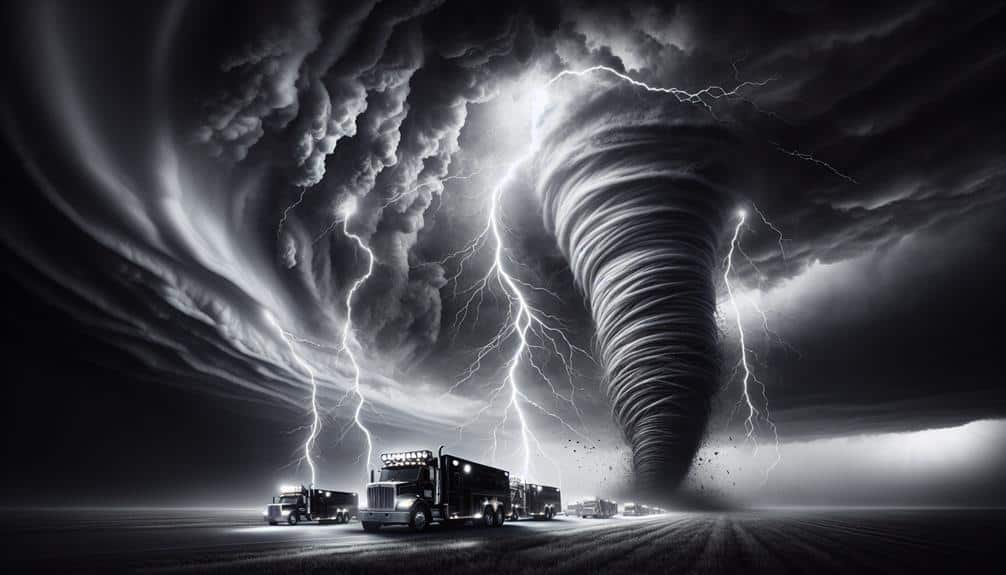We've identified three top-tier weather station setups that storm chasers can rely on for precise, real-time data and robust performance in extreme conditions. The Portable Weather Station Kit offers high-precision sensors and essential components like anemometers and barometers, ensuring accuracy. The Advanced Mobile Weather Unit integrates cutting-edge tech—GPS, radar, satellite data—and predictive models, enhancing efficiency. For agility, the Compact Storm Monitoring Gear provides handheld anemometers and GPS-enabled tablets, perfect for seamless data collection and sharing. Each setup is designed to maximize performance in demanding environments, so let's explore how these systems can elevate your storm chasing endeavors.
Key Points
- Portable Weather Station Kit: High-precision sensors and durability under extreme conditions ensure accurate data for emergency response scenarios.
- Advanced Mobile Weather Unit: Integrates GPS, radar, and satellite data for precise real-time monitoring and remote access capabilities.
- Compact Storm Monitoring Gear: Provides essential handheld tools and cloud-based platforms for seamless data sharing and mobility.
- Machine Learning Algorithms: Utilizes predictive models for accurate forecasting and enhanced storm chasing efficiency.
Portable Weather Station Kit
When setting up a portable weather station kit, we should focus on selecting high-precision sensors and guaranteeing the system's durability under extreme conditions. Precision is non-negotiable; accurate data can make a difference in emergency response scenarios. High-quality anemometers, barometers, and thermometers are essential. Each sensor must provide real-time data with minimal error margins, especially when monitoring severe weather.
Durability is equally important. Our portable weather station kits need to withstand harsh environments. Sturdy, weather-resistant enclosures protect delicate components against rain, wind, and debris. This ensures that our data collection remains uninterrupted, even in the most challenging weather conditions.
Remote monitoring capabilities are another vital aspect. By incorporating wireless communication technologies such as cellular, satellite, or long-range radio, we can transmit data from isolated locations directly to our base operations. This feature is essential for storm chasers who often operate in remote areas where immediate data access can enhance situational awareness and decision-making.
Advanced Mobile Weather Unit
Designing an advanced mobile weather unit requires integrating cutting-edge technology with robust data analytics to guarantee seamless and precise weather monitoring on the move. We need to focus on real-time tracking systems that provide instant updates on atmospheric conditions. These systems utilize GPS, radar, and satellite data to track storm paths, wind speeds, and precipitation levels with high precision.
Our mobile unit also needs remote monitoring capabilities, enabling us to control and access data from any location. This setup typically involves a combination of high-resolution sensors, wireless communication modules, and cloud-based data storage. By leveraging these technologies, we can analyze weather patterns and respond to changes without being physically present at the site.
Moreover, integrating machine learning algorithms and predictive models within the mobile unit enhances our ability to forecast severe weather events accurately. These advanced analytical tools process vast amounts of data, identifying trends and anomalies that might be overlooked by conventional methods.
Incorporating these features ensures that our advanced mobile weather unit not only tracks and monitors weather conditions in real time but also provides the freedom to operate and analyze data remotely, making our storm chasing endeavors notably more efficient and effective.
Compact Storm Monitoring Gear
For storm chasers, compact storm monitoring gear provides the vital tools to collect and analyze meteorological data efficiently while maintaining mobility. These portable devices are engineered to offer precision without the bulk, allowing us to navigate unpredictable weather conditions with agility.
Leveraging remote monitoring capabilities, we can access essential data from anywhere, reducing the need for constant physical proximity to the storm.
Key components of compact setups include handheld anemometers, barometers, and GPS-enabled tablets. These devices deliver real-time alerts, empowering us to make informed decisions rapidly. Handheld anemometers measure wind speed and direction with high accuracy, while barometers track atmospheric pressure changes, critical for predicting storm development. Pairing these with GPS-enabled tablets ensures we can log data accurately and consult it on-the-go.
Moreover, the integration of cloud-based platforms allows seamless data sharing and collaboration. Using remote monitoring systems, we can transmit data back to central units or other team members in real-time. This capability enhances our situational awareness and collective response efficiency.
As storm chasers, having compact, reliable gear not only keeps us nimble but also guarantees we remain at the forefront of weather analysis and safety.
Frequently Asked Questions
How Do Storm Chasers Ensure Their Safety While Tracking Severe Weather?
We safeguard our safety while tracking severe weather by taking safety precautions like monitoring real-time data, maintaining equipment regularly, and staying updated on weather patterns. Our freedom relies on precise analytics and disciplined equipment maintenance to stay safe.
What Are the Essential Apps for Storm Chasers?
We grasp the need for precision. Top apps for storm chasers include Weather tracking tools, Data collection software, GPS technology for navigation, and Emergency protocols. These apps enhance our safety precautions and guarantee accurate, real-time information.
How Can I Join a Storm Chasing Team?
To join a storm chasing team, we should focus on understanding team dynamics and enrolling in training programs. Meeting equipment requirements and seeking field research opportunities will guarantee we contribute effectively and gain valuable experience.
What Are the Legal Considerations for Storm Chasing?
Remember when we navigated that maze? Storm chasing's similar. We need legal permissions to access certain areas and must consider liability concerns to avoid potential lawsuits. Careful planning guarantees we chase storms while respecting laws and safety.
How Do Storm Chasers Communicate With Each Other in the Field?
We rely on various communication methods, including radios and mobile apps, to share real-time weather updates and our precise locations. Emergency protocols guarantee everyone's safety, allowing us to coordinate efficiently and respond swiftly to changing conditions.
